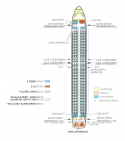Seating configuration is primarily a carrier's choice. Chinese carriers can squeeze more but they don't choose to do so like European/American carriers.
Not sure of Europe, but China and US is very different in travel mode. HSR is best option within 500km range, equally fast as airplane but more comfortable and cheaper. US does not have HSR, so airplane is the only choice even if uncomfortably squeezed. In China, one only take the flight if one has to go beyond 500km and fast. These people are rich enough to pay a few hundred Yuan for the comfort.
A person who can not afford to fly today would NOT choose to fly even if the price per seat is lowered by a few percent by squeezing in one more row. If that person want to go faster than K trains on a hard seat, he/she can choose HSR with an airline grade seat and much larger leg room.
Basically, China's HSR has killed short haul cheap airline business.
I don't think anyone is arguing about the fact that sub 500km routes in China are much better for HSR. I am specifically talking about the routes that are not best optimized for HSR - namely, the routes between the few major economic hubs in China - Beijing/Tianjin - Greater Bay Region - Yangtze River Delta - Wuhan - Changsha - Xi'an - Chengdu/Chongqing. Most of regions are more than 500km away and if you go on WeChat and check, HSR (namely the G-series trains) is routinely more expensive than flights for the busiest flight routes. So the notion that "HSR is cheaper than flying" doesn't hold up true for the busiest routes.


